glass tile
We don't get involved in renovations all that often, but in this case it would've been tough to say no. Not long before, we'd designed a new pool for right next door - a thoroughly modern watershape that looked great and was perfectly suited to the property and the architecture of the home. As work continued on site, it was apparent that one of the neighbors was more than a little
One of the things I like most about working in the watershaping business these days is how clever and creative designers and builders have become at what they do. It's not just the big details such as vanishing edges, play-pool configurations, sun shelves or swim-up bars. And it's about more than beach entries, grottos, laminar jets and cool spillways. Those are all great, every one of them, but what I'm talking about here is the attention to the small things - the subtle ways more and more watershapers are finding to make
Through many years of applying small pieces of tile to the complex sorts of surfaces found in pools, spas and other waterfeatures, I find most of the challenges (and opportunities) come in figuring out intersections - that is, places where planes meet, contours change and, in general, a whole lot of attention needs to be paid to getting things just right visually. We at Rock Solid Tile (Calabasas, Calif.) have been fortunate to find ourselves involved in many projects in which
For quality watershapes, there's nothing like a finish made up of mosaic glass tile: The material has a great look and a spectacular texture, comes in amazing colors and offers a full range of visual effects, from complete transparency to shimmering iridescence. It's the perfect crowning touch for an outstanding project if the budget is right - and that's where the trouble often starts. Through the years, I've inspected more than 40 projects in which
It's a small backyard with a Texas-size easement - and a good thing that I like challenges, because designing a project for this outdoors-loving family in Katy was an exercise in making a whole bunch of ideas fit comfortably within an unusually constrained space. As we learned, their gated-community property is separated from the street directly behind it by a tall boundary wall. This meant that there was no backing parcel to share
Even after years of operation in the tile-application business, we still find fresh challenges and new sources of pride in what we do. I think it's primarily because we spend so much of our time focusing on fine details - the little touches that turn routine work into creative exercises and repetitive tasks into ongoing sparks of inspiration. A case in point is the huge job on display in this article: The three watershapes encompass vast square footage that includes fields of
When outsiders think of Texas, they very often assume that it's flat as a pancake with no topographical distinctions to consider. That may be true in some parts of our big state, but where I live and work in the vicinity of Austin, there are areas that offer great views and have attracted developers who are intent on using those prospects to full advantage. The spec home featured in this article is an example of this trend: It's in Westlake Hills, a small neighborhood within Austin's city limits that affords some amazing views of
Once U.S. designers and builders "discovered" vanishing edges - probably at some point in the 1980s, although the look emerged long before then with some forward-thinking architects and watershapers - we've never let this highly visual design detail go. I use these edge effects in my designs all the time, and setting them up in the best way possible has




















